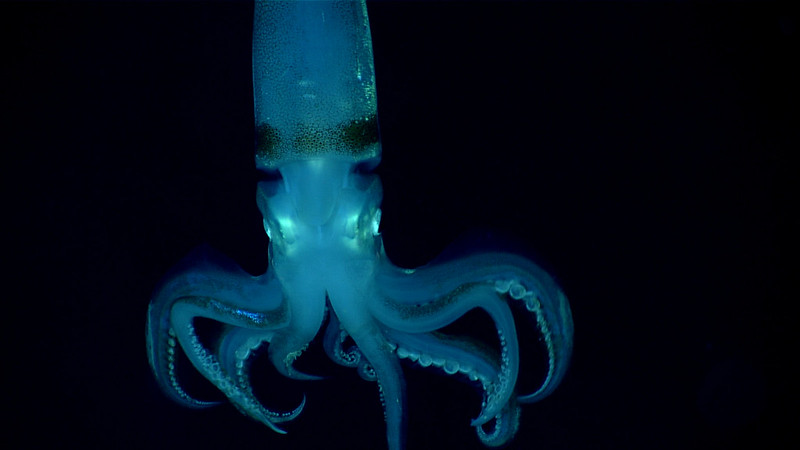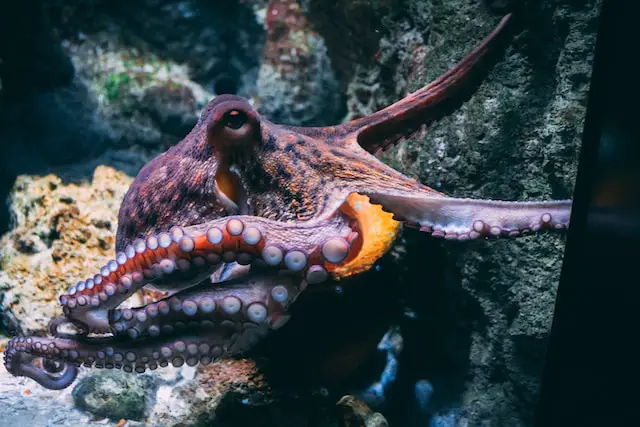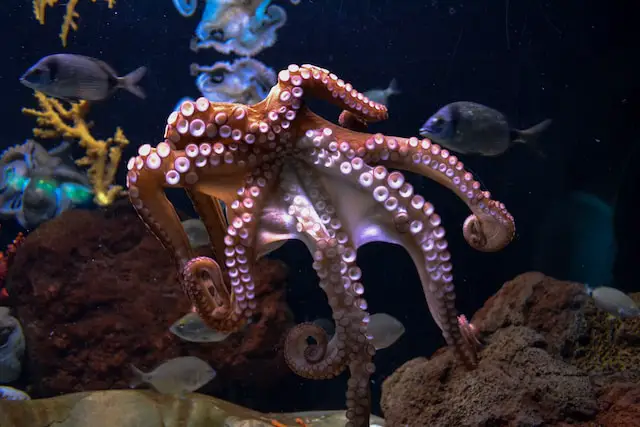Squids have longer bodies than octopuses and are also capable of swimming quickly with their fins. Octopuses lack fins, so they must use jet propulsion to move about in the water. They also possess eight tentacles instead of ten like squids do, which is a key distinguishing feature between the two species.
What is a Squid?
(Phot By NOAA Ocean Exploration on Flickr)

A squid is a cephalopod mollusc in the class Cephalopoda. Squid have a cylindrical body, and eight arms and two tentacles. Squid are fast swimmers and jet through the water using a siphon to expel water from their bodies. This gives them their signature long, stream-lined shape.
Squid vary in size, with the largest reaching up to 18 meters (59 ft) in length. The smallest species of squid are only a few centimeters long when fully grown. Most squid species range between these extremes in size. Squid can be found in all oceans at depths of up to 1,000 meters (3,300 ft).
Most squid are predators and use their well-developed eyesight and fast swimming abilities to hunt prey. Their diet typically consists of small fish, shrimp, crabs, and other small marine creatures. Some larger squid species also feed on fish and mammals such as porpoises.
What is an Octopus?
(Photo by Diane Picchiottino on Unsplash )

An octopus is a cephalopod mollusc of the order Octopoda. Around 300 species are recognized, which is over one-third of the total number of known cephalopod species. The octopus inhabits diverse regions, including ocean coasts and the open ocean. They are commonly found in coral reefs, kelp forests, seagrass beds, and on or near the seafloor. They are carnivorous predators and mostly eat crustaceans, molluscs, and fishes.
The octopus has a soft body that can quickly change shape to help it squeeze through tight places. It also uses its tentacles to grab prey and bring it to its mouth for eating. Octopuses are very good at camouflage and can change their color and skin texture to match their surroundings. This helps them hide from predators and also helps them sneak up on prey.
Squid Vs. Octopus – Key differences
Squid and octopuses are both cephalopods, a group of mollusks that also includes nautiluses and cuttlefish. All cephalopods have bilateral symmetry, a well-defined head, and a mantle that covers their internal organs. Cephalopods are the most advanced mollusks, with sophisticated nervous systems and complex eyes.
Squid are more closely related to cuttlefish than they are to octopuses. Squid have a long, tubular body with eight arms and two tentacles. Their mantle is open at the back, allowing them to swim by expelling water from their siphon. Squid also have a fin on each side of their body for stability.
Octopuses are more closely related to nautiluses than they are to squid. Octopuses have a shorter, more compact body than squid, and they lack fins. Instead of arms, they have eight tentacles that they use for walking and grasping prey. Octopuses also have a siphon, but unlike squid, their mantle is completely enclosed.
There are several key differences between squid and octopuses:
- Body shape: Squid have a long, tubular body while octopuses have a shorter, more compact body.
- Arms vs. tentacles: Squid have eight arms while octopuses have eight tentacles. Tentacles are used for walking and grasping prey while arms are used for swimming
The physical differences between squids and octopuses
There are several physical differences between squids and octopuses. For one, squids have a distinct head and body, while octopuses have a more muddled appearance with their eight arms stretching out from their central body. Additionally, squids have two shorter tentacles used for feeding and locomotion, while octopuses have eight longer tentacles (two of which are usually shorter than the rest) used primarily for locomotion and manipulation.
Furthermore, squids have unique internal shells called pens, while octopuses do not have any type of internal shell. Finally, squids tend to be faster and more agile in the water than octopuses, due to their sleek bodies and powerful fins.
The behavioral differences between squids and octopuses
Squids and octopuses are both cephalopods, which means they have a head and tentacles. Both squids and octopuses are able to change the color of their skin for camouflage and communication. But that’s where the similarities end. Here are some behavioral differences between squids and octopuses:
- Squids are active during the day, while octopuses are active at night.
- Squids live in open water, while octopuses live in caves or crevices on the sea floor.
- Squids swim by jet propulsion, while octopuses crawl along the seafloor.
- Octopuses are solitary creatures, while squids often travel in schools.
- Octopuses are more intelligent than squids and have been known to solve complex puzzles.
Is calamari a squid or octopus?
Calamari is a seafood dish that is made from squid. The word calamari comes from the Italian word for squid, which is calamaro. Squid and octopus are both cephalopods, which means that they have a head and tentacles.Squid have ten tentacles, while octopus have eight. Both squid and octopus have a beak, but the squid’s beak is hidden by its tentacles. Squid are also generally smaller than octopus. Another difference between squid and octopus is that squid have a pen, which is an internal shell. Octopus do not have a shell.
Is squid and octopus the same to eat?
Squid and octopus are not the same to eat. While they are both mollusks and have some similarities in appearance and texture, they have distinct differences in taste, flavor, and culinary uses.
Squid has a milder flavor and firmer texture compared to octopus. It is often used in dishes such as calamari, which are deep-fried rings of squid, and in stews, soups, and pasta dishes. Squid can also be grilled, sautéed, or roasted, and is often served as a popular seafood appetizer.
Octopus, on the other hand, has a more complex flavor and a softer, chewy texture. It is often used in dishes such as sushi, sashimi, and ceviche, where it is served raw or lightly cooked. Octopus can also be grilled, boiled, or braised, and is a popular ingredient in Mediterranean and Asian cuisine.
While both squid and octopus are nutritious and low in fat, they have different nutritional profiles. Squid is rich in protein and minerals such as iron and phosphorus, while octopus is high in omega-3 fatty acids, vitamin B12, and other essential nutrients.
In summary, while squid and octopus are similar in some ways, they have distinct culinary uses and flavors. Whether they are enjoyed raw or cooked, they offer unique and delicious seafood options for those who enjoy them.
Are octopus or squid venomous?
Some species of octopus and squid are venomous, which means they can produce toxins that can be harmful to humans if injected through a bite or sting. These species are typically found in the wild and are not commonly consumed as food.
The venom of octopuses and squids is produced in their salivary glands and is used primarily for defense and hunting. Most species of octopus and squid are not venomous to humans, and their bites or stings are usually not dangerous or life-threatening. However, some species, such as the blue-ringed octopus, are highly venomous and can cause serious harm or even death if their venom is not treated promptly.
It is important to note that commercially available octopus and squid that are used for food have been properly prepared and cooked, which neutralizes any toxins that may be present. These seafood products are safe and healthy to eat when purchased from reputable sources and prepared correctly.
Why is squid blood blue in color?
Squid blood is blue in color because it contains a copper-rich protein called hemocyanin. Hemocyanin is responsible for transporting oxygen throughout the squid’s body and is similar in function to hemoglobin, which is found in the blood of vertebrates like humans.
The blue color of hemocyanin is due to the presence of copper ions, which bind to oxygen and create a blue-colored complex. When oxygenated, the hemocyanin in the squid’s blood appears bright blue or turquoise in color. In contrast, the hemoglobin found in human blood contains iron ions, which bind to oxygen and create a red-colored complex, giving human blood its characteristic red color.
The blue color of squid blood can be seen in live specimens or freshly caught squid, where it is visible through their translucent skin. However, the blood of squid and other cephalopods rapidly turns colorless after the animal dies, making it difficult to observe the blue color outside of live specimens.
Featured Image By – Serena Repice Lentini on Unsplash








